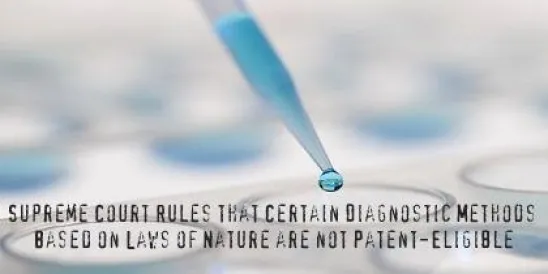The United States Supreme Court ruled unanimously in Mayo v. Prometheus that in order for an invention that is drawn to an application of a law of nature to be patent-eligible, the invention must limit its reach to a specific inventive application of the law of nature.
The issue before the Supreme Court was to determine whether the patents at issue in Mayo relate to patent-eligible subject matter under 35 U.S.C. § 101, namely “any new and useful process, machine, manufacture, or composition of matter, or any new and useful improvement thereof.” Laws of nature and mathematical formulae are not patent-eligible on their own, although they may be eligible for patent protection when applied to certain structures or processes.
Prometheus Laboratories (Prometheus) is the exclusive licensee of two patents drawn to methods of optimizing treatment of autoimmune diseases with thiopurine drugs. In prescribing these drugs, physicians had experienced difficulties in identifying optimized dosage levels to balance efficacy with toxicity. The claimed methods in Prometheus’ patents include active steps of “administering” the drug to a subject and “determining” a level of metabolite in the subject. The claims also include “wherein” clauses that provide guidance to the physician for adjusting the level of administered drug based on the levels of metabolite that are determined.
After Prometheus sued Mayo for patent infringement, the patent claims were rejected by the district court as being invalid under Section 101. On appeal, the Federal Circuit upheld the claims as being directed to patent-eligible subject matter under Section 101, first in 2009 under the Federal Circuit’s “machine-or-transformation” test and again on remand from the Supreme Court in 2010 in view of the Supreme Court’s decision in Bilski v. Kappos.
The Supreme Court held that the claims of the Prometheus patents at issue are not patent-eligible, reasoning that the claims are, “a drafting effort designed to monopolize the law of nature itself” rather than being a genuine application of a law of nature. That is, the Court believed the methods to be based on laws of nature (i.e. correlation of metabolite levels to optimal drug dosage) by failing to “add enough to their statements of the correlations to allow the processes they describe to qualify as patent-eligible processes that apply natural laws.”
The Court in Mayo noted that the “administering” and “determining” steps were both well known in the art at the time of invention and that the information in the “wherein” clauses was nothing more than a statement of the relevant natural laws. Thus, in parsing the claim language, the Court argued that claiming these steps as a combination adds nothing that was not already present when the steps are considered separately.
While it may take time to realize the full implications of this decision, initially it is likely to create uncertainty for patents relating to diagnostic methods and in particular, patents in the emerging field of personalized medicine. To be patent-eligible, it appears that patent claims will now have to rely on more than correlations or relationships between variables, as these may be dismissed as an attempt to monopolize a “law of nature.”



 />i
/>i

